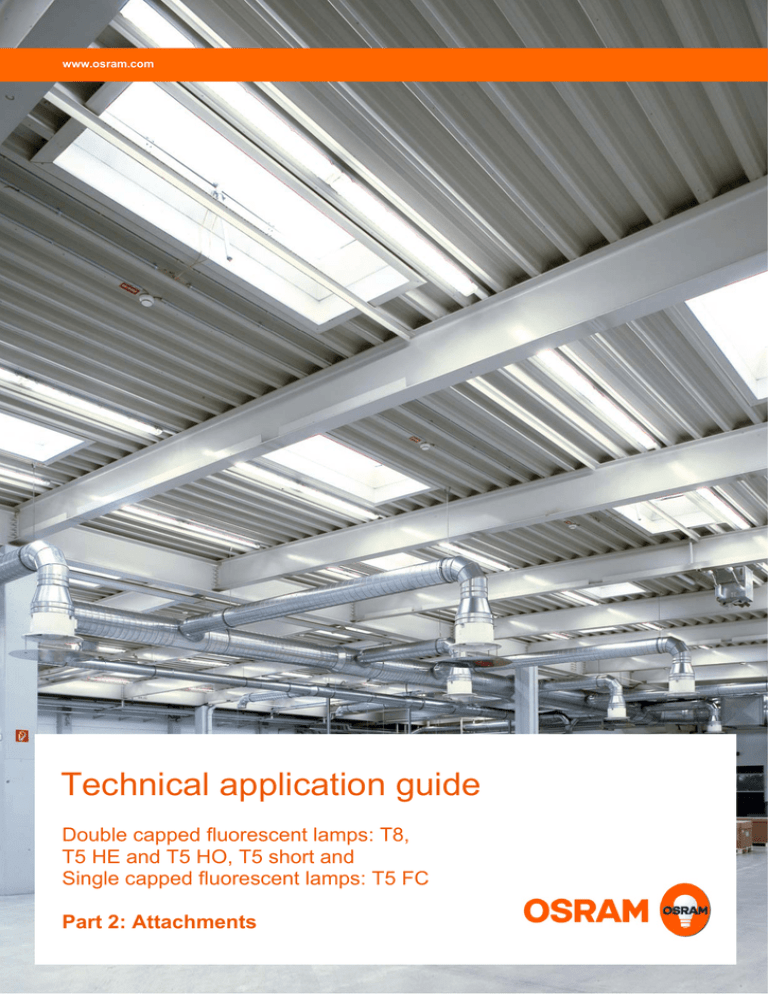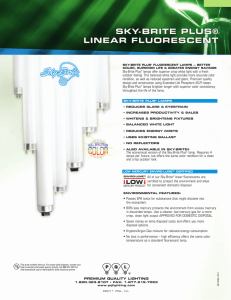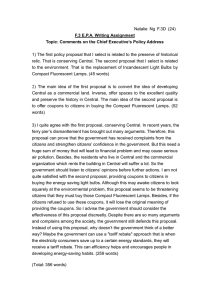
www.osram.com
Technical application guide
Double capped fluorescent lamps: T8,
T5 HE and T5 HO, T5 short and
Single capped fluorescent lamps: T5 FC
Part 2: Attachments
Edition: 08.2013
Subject to change without notice
Despite careful review, the possibility of mistakes can’t be excluded – no guaranty will be taken
August 2013. Copyright© OSRAM GmbH.
All rights reserved, reproduction in whole or parts is prohibited without prior permission.
Technical guide „double and single capped fluorescent lamps” T8, T5 and T5 FC
Attachment 1......................................................................................................................................... 5
Overview starter and single and double capped fluorescent lamps combinations .......................... 5
Attachment 2......................................................................................................................................... 6
Spectral distribution for LUMILUX® INTERNA 827 ............................................................................. 6
Spectral distribution for LUMILUX® Warm White 830....................................................................... 7
Spectral distribution for LUMILUX® White 835 ................................................................................. 8
Spectral distribution for LUMILUX® Cool White 840 ......................................................................... 9
Spectral distribution for LUMILUX® Cool Daylight 865 .................................................................... 10
Spectral distribution for LUMILUX® SKYWHITE® 880 ....................................................................... 11
Attachment 3....................................................................................................................................... 12
Spectral distribution for LUMILUX® DE LUXE Warm White 930 ...................................................... 12
Spectral distribution for LUMILUX® DE LUXE Cool White 940 ......................................................... 13
Spectral distribution for LUMILUX® DE LUXE Daylight 954.............................................................. 14
Spectral distribution for LUMILUX® DE LUXE Cool Daylight 965 ..................................................... 15
Attachment 4....................................................................................................................................... 16
Spectral distribution for special colours BIOLUX® 965 .................................................................... 16
Spectral distribution for special colours CHIP® Control 62 .............................................................. 17
Spectral distribution for special colours FLUORA® 77 ..................................................................... 18
Spectral distribution for special colours NATURA® 76..................................................................... 19
Spectral distribution for special colours COLOR Control 940.......................................................... 20
Spectral distribution for special colours COLOR Control 954.......................................................... 21
Spectral distribution for special colours colour Blue 67 ................................................................. 22
Spectral distribution for special colours colour Green 66............................................................... 23
Spectral distribution for special colours colour Red 60 .................................................................. 24
Spectral distribution for special colours colour Yellow 62 .............................................................. 25
Attachment 5: Reflector information sheet ........................................................................................ 26
Attachment 6: Fluorescent lighting ..................................................................................................... 28
What can go wrong and how to correct it?..................................................................................... 28
What can go wrong and how to correct it (other factors)? ............................................................ 29
Attachment 7: Fluorescent lighting ..................................................................................................... 30
Other issues to consider .................................................................................................................. 30
Attachment 8....................................................................................................................................... 32
Technical Information: Starter St 111 HT Longlife .......................................................................... 33
Technical Information: Starter St 111 Longlife ............................................................................... 34
Technical Information: Starter St 151 Longlife ............................................................................... 36
Technical Information: Starter DEOS St 171 SAFETY ....................................................................... 38
Technical guide „double and single capped fluorescent lamps” T8, T5 and T5 FC
Technical Information: Starter DEOS St 172 SAFETY ....................................................................... 40
Technical Information: Starter DEOS St 173 SAFETY ....................................................................... 42
Attachment 9....................................................................................................................................... 44
Optical safety declaration fluorescent lamps.................................................................................. 44
Attachment 10..................................................................................................................................... 45
Conformity declaration for T8 fluorescent lamps ........................................................................... 45
Conformity declaration for T5 fluorescent lamps ........................................................................... 50
Attachment 11..................................................................................................................................... 55
Energy balance for linear fluorescent lamps 26 mm (T8) CCG operation ....................................... 55
Energy balance for linear fluorescent lamps 26 mm (T8) ECG operation ....................................... 56
Energy balance for linear fluorescent lamps 16 mm (T5) ECG operation ....................................... 57
4
Attachment 1
Overview starter and single and double capped fluorescent lamps combinations
5
Technical guide „double and single capped fluorescent lamps” T8, T5 and T5 FC
Technical guide „double and single capped fluorescent lamps” T8, T5 and T5 FC
Attachment 2
®
Spectral distribution for LUMILUX INTERNA 827
6
Technical guide „double and single capped fluorescent lamps” T8, T5 and T5 FC
Attachment 2
®
Spectral distribution for LUMILUX Warm White 830
7
Technical guide „double and single capped fluorescent lamps” T8, T5 and T5 FC
Attachment 2
®
Spectral distribution for LUMILUX White 835
8
Technical guide „double and single capped fluorescent lamps” T8, T5 and T5 FC
Attachment 2
®
Spectral distribution for LUMILUX Cool White 840
9
Technical guide „double and single capped fluorescent lamps” T8, T5 and T5 FC
Attachment 2
®
Spectral distribution for LUMILUX Cool Daylight 865
10
Technical guide „double and single capped fluorescent lamps” T8, T5 and T5 FC
Attachment 2
®
®
Spectral distribution for LUMILUX SKYWHITE 880
11
Technical guide „double and single capped fluorescent lamps” T8, T5 and T5 FC
Attachment 3
®
Spectral distribution for LUMILUX DE LUXE Warm White 930
12
Technical guide „double and single capped fluorescent lamps” T8, T5 and T5 FC
Attachment 3
®
Spectral distribution for LUMILUX DE LUXE Cool White 940
13
Technical guide „double and single capped fluorescent lamps” T8, T5 and T5 FC
Attachment 3
®
Spectral distribution for LUMILUX DE LUXE Daylight 954
14
Technical guide „double and single capped fluorescent lamps” T8, T5 and T5 FC
Attachment 3
®
Spectral distribution for LUMILUX DE LUXE Cool Daylight 965
15
Technical guide „double and single capped fluorescent lamps” T8, T5 and T5 FC
Attachment 4
®
Spectral distribution for special colours BIOLUX 965
16
Technical guide „double and single capped fluorescent lamps” T8, T5 and T5 FC
Attachment 4
®
Spectral distribution for special colours CHIP Control 62
17
Technical guide „double and single capped fluorescent lamps” T8, T5 and T5 FC
Attachment 4
®
Spectral distribution for special colours FLUORA 77
18
Technical guide „double and single capped fluorescent lamps” T8, T5 and T5 FC
Attachment 4
®
Spectral distribution for special colours NATURA 76
19
Technical guide „double and single capped fluorescent lamps” T8, T5 and T5 FC
Attachment 4
Spectral distribution for special colours COLOR Control 940
20
Technical guide „double and single capped fluorescent lamps” T8, T5 and T5 FC
Attachment 4
Spectral distribution for special colours COLOR Control 954
21
Technical guide „double and single capped fluorescent lamps” T8, T5 and T5 FC
Attachment 4
Spectral distribution for special colours colour Blue 67
22
Technical guide „double and single capped fluorescent lamps” T8, T5 and T5 FC
Attachment 4
Spectral distribution for special colours colour Green 66
23
Technical guide „double and single capped fluorescent lamps” T8, T5 and T5 FC
Attachment 4
Spectral distribution for special colours colour Red 60
24
Technical guide „double and single capped fluorescent lamps” T8, T5 and T5 FC
Attachment 4
Spectral distribution for special colours colour Yellow 62
25
Technical guide „double and single capped fluorescent lamps” T8, T5 and T5 FC
Attachment 5: Reflector information sheet
By courtesy of Jordan Reflektoren GmbH
26
Technical guide „double and single capped fluorescent lamps” T8, T5 and T5 FC
Attachment 5: Reflector information sheet
By courtesy of Jordan Reflektoren GmbH
27
28
X
Slow run-up
X
X
X
X
Short lamp life
X
X
X
X
X
X
New lamps fail
within a few days
X
X
Lamps that fail to
light
X
X
X
X
X
ECG
improperly
operates
lamp
Dim center
X
Snaking/Flickering
lamps
ECG
at end
of life
X
X
Dark ends
Failed
ECG
Reduced output of
luminous flux
Wrong
ECG
Issue/Cause
ECG
By courtesy of OSRAM Sylvania
Attachment 6: Fluorescent lighting
What can go wrong and how to correct it?
X
Normal
drop of
luminous
flux
Lamp
Technical guide „double and single capped fluorescent lamps” T8, T5 and T5 FC
X
X
X
X
Normal
end of
life
X
Normal
attrition
of
cathode
coating
X
X
Normal
failure/short
operation
cycle
X
X
X
X
X
X
X
Impurities
in lamp
X
X
X
X
X
X
Noble
gas
leak
X
X
X
X
X
X
Poor
lamp/socket
contact
X
X
X
X
X
X
X
Wrong
lamps
for
EVG
X
X
Snaking/Flickering
lamps
Reduced luminous
flux
X
X
X
X
X
X
Short lamp life time
X
X
New lamps fail
within few days
X
X
Dark ends
X
Slow starting
X
Improper
wiring/
circuit
X
X
Lamps don’t switch
-on
Blown
fuse
Dim center
Dark spots on lamp
Line
voltage
too high
or too low
Issue/cause
Voltage/Circuit/wiring
By courtesy of OSRAM Sylvania
Attachment 6: Fluorescent lighting
What can go wrong and how to correct it (other factors)?
X
X
No
ground
plane
X
X
X
Air
currents
X
X
X
X
X
X
Extreme
temperatures
External condition
X
X
Dirty
lighting
fixture
X
X
High
Humidity
X
X
X
Starter at
end of life
Starter
X
X
X
X
X
X
X
X
29
Wrong or
failed
starter
Technical guide „double and single capped fluorescent lamps” T8, T5 and T5 FC
Technical guide „double and single capped fluorescent lamps” T8, T5 and T5 FC
Attachment 7: Fluorescent lighting
Other issues to consider
By courtesy of OSRAM Sylvania
More about dark spots and streaks
Dark sports are droplets of condensed mercury. They sometimes appear in new lamps and will
evaporate and disappear after the lamps are operated for a few hours.
Dark spots or streaks of condensed mercury may also appear if a heat-conducting object, such a
light fitting louver or reflector, is too close to the glass wall of the lamp. The object is conducting
heat away from the glass wall of the lamp and creating an acceptable cold spot. The distance
between the object and the glass wall of the lamp must be increased in order to eliminate the
issue. Minimum recommended distance between the object and the glass wall is 6 mm and 10
mm for T5 HE and HO Seamless.
Rotating the lamp 180° may eliminate the spots/streaks temporarily but they will return as long
as the section of the lamp glass wall is too cool.
Don’t use metal springs or clips to maintain fluorescent lamps in position.
An artificial cold spot is created on the lamp glass wall by the contact between the metal clip, the
light fitting housing and lamp. Under those conditions Hg will condensate and create black ring
around the fixation. Optimum luminous flux will not be achieved under this condition.
Those clips have to be made in a synthetic and insulating material that is UV resistent and are
resistant to variations in temperature so that extreme dillatation is avoided. Those kinds of clips
are proposed by leading lampholder manufacturers.
Lower luminous flux than expected
Check the ballast factor of the ECG. You may need to refer to the ECG manufacturer’s catalogue
for this information. The ballast factor is the percentage of the published luminous flux
(measured on an IEC reference ballast) that the actual ECG delivers.
Check for other equipment in the facility that may be reducing the line voltage at the traditional
ballast (CCG).
For ECG contact the ECG manufacturer for information about line voltage stability.
Don’t forget that fluorescent lamps are temperature sensitive. Ambient temperatures that are
too high or too low will drop the luminous flux of the lamp.
Air stream directed on the lamp will cooling the lamps and causing a drop in luminous flux.
Consider adding plastic tube guards or using enclosed light fittings in low temperatures or draffy
applications.
Use only plastic tube guards that are UV resistant and heat resistant.
Slow run-up of the fluorescent lamps
30
T5 HO CONSTANT 49 W fluorescent lamps (AMALGAM) may have a longer run-up time than cold
spot lamps T5 HO 49 W.
Colour temperature of the lamp
Check colour temperature of the lamps first after 100 h aging.
Check for multiple production barches. There can be slight variations and all lamps still be within
the standard.
Lamp colour temperature, as well as luminous flux output, may also be affected if a heatconducting object is too close to the glass wall of the lamp.
Technical guide „double and single capped fluorescent lamps” T8, T5 and T5 FC
New fluorescent lamps will not start.
Dimming fluorescent lamps
If this is a newer T5 HE, T5 HO or T8 installation, the ballast may have an end of life detection.
Try switching-off the power, then switching it on to reset the detection circuit.
Before dimming of a fluorescent lamp (all types) it is necessary to operate the lamps at full
power and age them under those operating conditions for 100 h. It will avoid that blackening of
the electrodes appear with as consequence that life time of the lamp will be reduced.
Cold temperature applications
Is the ECG appropriated for the application? Check the ECG label for the minimum ambient
temperature at which it will start the lamp.
T8 fluorescent lamps operated with a CCG and a traditional starter, check temperature range of
the starter. Replace starter and lamp together, it will avoid that new lamps operate with starters
that already were a long time in operation.
Use closed light fittings for outdoor applications.
For outdoor applications in case that the T5 Lamps HO CONSTANT are installed in vertical
operation position, it is recommended to mount the HO CONSTANT lamp with it etch (Stamp)
upwards.
31
Technical guide „double and single capped fluorescent lamps” T8, T5 and T5 FC
Attachment 8
Starters ST111 LONGLIFE compared to ST151 LONGLIFE - Construction
32
Technical guide „double and single capped fluorescent lamps” T8, T5 and T5 FC
Technical Information: Starter St 111 HT Longlife
33
Technical guide „double and single capped fluorescent lamps” T8, T5 and T5 FC
Technical Information: Starter St 111 Longlife
34
Technical guide „double and single capped fluorescent lamps” T8, T5 and T5 FC
35
Technical guide „double and single capped fluorescent lamps” T8, T5 and T5 FC
Technical Information: Starter St 151 Longlife
36
Technical guide „double and single capped fluorescent lamps” T8, T5 and T5 FC
37
Technical guide „double and single capped fluorescent lamps” T8, T5 and T5 FC
Technical Information: Starter DEOS St 171 SAFETY
38
Technical guide „double and single capped fluorescent lamps” T8, T5 and T5 FC
39
Technical guide „double and single capped fluorescent lamps” T8, T5 and T5 FC
Technical Information: Starter DEOS St 172 SAFETY
40
Technical guide „double and single capped fluorescent lamps” T8, T5 and T5 FC
41
Technical guide „double and single capped fluorescent lamps” T8, T5 and T5 FC
Technical Information: Starter DEOS St 173 SAFETY
42
Technical guide „double and single capped fluorescent lamps” T8, T5 and T5 FC
43
Technical guide „double and single capped fluorescent lamps” T8, T5 and T5 FC
Attachment 9
Optical safety declaration fluorescent lamps
44
Technical guide „double and single capped fluorescent lamps” T8, T5 and T5 FC
Attachment 10
Conformity declaration for T8 fluorescent lamps
45
Technical guide „double and single capped fluorescent lamps” T8, T5 and T5 FC
46
Technical guide „double and single capped fluorescent lamps” T8, T5 and T5 FC
47
Technical guide „double and single capped fluorescent lamps” T8, T5 and T5 FC
48
Technical guide „double and single capped fluorescent lamps” T8, T5 and T5 FC
49
Technical guide „double and single capped fluorescent lamps” T8, T5 and T5 FC
Conformity declaration for T5 fluorescent lamps
50
Technical guide „double and single capped fluorescent lamps” T8, T5 and T5 FC
51
Technical guide „double and single capped fluorescent lamps” T8, T5 and T5 FC
52
Technical guide „double and single capped fluorescent lamps” T8, T5 and T5 FC
53
Technical guide „double and single capped fluorescent lamps” T8, T5 and T5 FC
54
Technical guide „double and single capped fluorescent lamps” T8, T5 and T5 FC
Attachment 11
Energy balance for linear fluorescent lamps 26 mm (T8) CCG operation
55
Technical guide „double and single capped fluorescent lamps” T8, T5 and T5 FC
Energy balance for linear fluorescent lamps 26 mm (T8) ECG operation
56
Technical guide „double and single capped fluorescent lamps” T8, T5 and T5 FC
Energy balance for linear fluorescent lamps 16 mm (T5) ECG operation
57
www.osram.com
NEW! OSRAM Lamp Finder
Professional – the free app
As the name suggests, the new
“OSRAM Lamp Finder Professional”
app for Apple and Android smartphones
and tablets will help you to find the right
lamp for your particular requirements.
OSRAM GmbH
Hauptverwaltung
Marcel-Breuer-Straße 6
80807 München
Fon +49 (0)89-6213-0
Fax +49 (0)89-6213-20 20
www.osram.com
08/13 Subject to change without notice. Errors and omissions excepted.
www.osram.com/lampfinder-app





